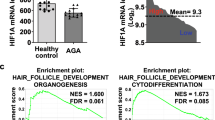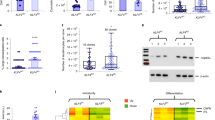Abstract
The present study investigates the efficacy of polyethylenimine (PEI)–DNA complex that expressed human telomerase reverse transcriptase (hTERT) to transfect hair follicle stem cells and produce sufficient hTERT to stimulate hair growth. Transfection with pLC–hTERT–DNA–PEI complex (D+P group) in vitro induced expression of proliferating cell nuclear antigen in 35.8% of the purified stem cell population, suggesting enhanced cell proliferation. In vivo transfection efficiency of rat dorsal skin was determined by staining for β-gal activity. Cells positive for β-gal were located in the bulge region and dermal sheath of hair follicles. The follicles in the hTERT-transfected region entered anagenon day 15 after transfection, whereas non-transfected (Neg) controls remained in telogen. The similar effect was observed in 50-day-old rat dorsal skin. D+P group displayed a specific expression of hTERT and sufficient to initiate a transition to the anagen phase and promote new hair synthesis 18 days after the transfection. hTERT promoted follicle neogenesis following wounding. In all, 60 days after wounding, tissues of the D+P group showed more newly regenerating hair follicles (83±52 regenerated follicles per rat) in contrast to control group tissues (15±15 regenerated follicles per rat). These studies provide a potential approach for gene therapy of skin disease.
This is a preview of subscription content, access via your institution
Access options
Subscribe to this journal
Receive 12 print issues and online access
$259.00 per year
only $21.58 per issue
Buy this article
- Purchase on Springer Link
- Instant access to full article PDF
Prices may be subject to local taxes which are calculated during checkout






Similar content being viewed by others
References
Jones PH, Watt FM . Separation of human epidermal stem cells from transit amplifying cells on the basis of differences in integrin function and expression. Cell 1993; 73: 713–724.
Tani H, Morris RJ, Kaur P . Enrichment for murine keratinocyte stem cells based on cell surface phenotype. Proc Natl Acad Sci USA 2000; 97: 10960–10965.
Hwang J, Mehrani T, Millar SE, Morasso MI . Dlx3 is a crucial regulator of hair follicle differentiation and cycling. Development 2008; 135: 3149–3159.
Ito M, Yang Z, Andl T, Cui C, Kim N, Millar SE et al. Wnt-dependent de novo hair follicle regeneration in adult mouse skin after wounding. Nature 2007; 447: 316–320.
Choi J, Southworth LK, Sarin KY, Venteicher AS, Ma W, Chang W et al. TERT promotes epithelial proliferation through transcriptional control of a Myc- and Wnt-related developmental program. PLoS Genet 2008; 4: e10.
Park JI, Venteicher AS, Hong JY, Choi J, Jun S, Shkreli M et al. Telomerase modulates Wnt signalling by association with target gene chromatin. Nature 2009; 460: 66–72.
Sarin KY, Cheung P, Gilison D, Lee E, Tennen RI, Wang E et al. Conditional telomerase induction causes proliferation of hair follicle stem cells. Nature 2005; 436: 1048–1052.
Ohyama M, Vogel JC . Gene delivery to the hair follicle. J Investig Dermatol Symp Proc 2003; 8: 204–206.
Saito N, Zhao M, Li L, Baranov E, Yang M, Ohta Y et al. High efficiency genetic modification of hair follicles and growing hair shafts. Proc Natl Acad Sci USA 2002; 99: 13120–13124.
Yang CH, Shen SC, Lee JC, Wu PC, Hsueh SF, Lu CY et al. Seeing the gene therapy: application of gene gun technique to transfect and decolour pigmented rat skin with human agouti signalling protein cDNA. Gene Therapy 2004; 11: 1033–1039.
Cheng H, Zhu JL, Zeng X, Jing Y, Zhang XZ, Zhuo RX et al. Targeted gene delivery mediated by folate-polyethylenimine-block-poly(ethylene glycol) with receptor selectivity. Bioconjug Chem 2009; 20: 481–487.
Shim MS, Kwon YJ . Acid-responsive linear polyethylenimine for efficient, specific, and biocompatible siRNA delivery. Bioconjug Chem 2009; 20: 488–499.
Zhao QQ, Chen JL, Lv TF, He CX, Tang GP, Liang WQ et al. N/P ratio significantly influences the transfection efficiency and cytotoxicity of a polyethylenimine/chitosan/DNA complex. Biol Pharm Bull 2009; 32: 706–710.
Domashenko A, Gupta S, Cotsarelis G . Efficient delivery of transgenes to human hair follicle progenitor cells using topical lipoplex. Nat Biotechnol 2000; 18: 420–423.
Itaka K, Kataoka K . Recent development of nonviral gene delivery systems with virus-like structures and mechanisms. Eur J Pharm Biopharm 2009; 71: 475–483.
Ko YT, Bhattacharya R, Bickel U . Liposome encapsulated polyethylenimine/ODN polyplexes for brain targeting. J Control Release 2009; 133: 230–237.
Wong K, Sun G, Zhang X, Dai H, Liu Y, He C et al. PEI-g-chitosan, a novel gene delivery system with transfection efficiency comparable to polyethylenimine in vitro and after liver administration in vivo. Bioconjug Chem 2006; 17: 152–158.
Wu Y, Fei Z, Lee LJ, Wyslouzil BE . Coaxial electrohydrodynamic spraying of plasmid DNA/polyethylenimine (PEI) polyplexes for enhanced nonviral gene delivery. Biotechnol Bioeng 2009; 105: 834–841.
Zhang L, Hu CH, Cheng SX, Zhuo RX . PEI grafted hyperbranched polymers with polyglycerol as a core for gene delivery. Colloids Surf B Biointerfaces 2010; 76: 427–433.
Gao JQ, Zhao QQ, Lv TF, Shuai WP, Zhou J, Tang GP et al. Gene-carried chitosan-linked-PEI induced high gene transfection efficiency with low toxicity and significant tumor-suppressive activity. Int J Pharm 2009; 387: 286–294.
Funhoff AM, van Nostrum CF, Koning GA, Schuurmans-Nieuwenbroek NM, Crommelin DJ, Hennink WE et al. Endosomal escape of polymeric gene delivery complexes is not always enhanced by polymers buffering at low pH. Biomacromolecules 2004; 5: 32–39.
Kobayashi K, Rochat A, Barrandon Y . Segregation of keratinocyte colony-forming cells in the bulge of the rat vibrissa. Proc Natl Acad Sci USA 1993; 90: 7391–7395.
Schlake T . Determination of hair structure and shape. Semin Cell Dev Biol 2007; 18: 267–273.
Acknowledgements
This research work was supported by a grant from National Science Council of the Republic of China (NSC99-2218-E-002-011).
Author information
Authors and Affiliations
Corresponding authors
Ethics declarations
Competing interests
The authors declare no conflict of interest.
Additional information
Supplementary Information accompanies the paper on Gene Therapy website
Supplementary information
Rights and permissions
About this article
Cite this article
Jan, HM., Wei, MF., Peng, CL. et al. The use of polyethylenimine–DNA to topically deliver hTERT to promote hair growth. Gene Ther 19, 86–93 (2012). https://doi.org/10.1038/gt.2011.62
Received:
Accepted:
Published:
Issue Date:
DOI: https://doi.org/10.1038/gt.2011.62



